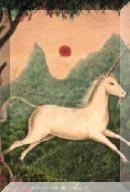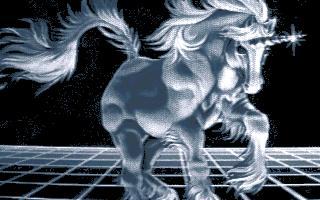The Legend of the Unicorn
In China, around 2800 BC, the Emperor Fu Hsi wrote of seeing a "k'i-lin" - he saw the symbols for "k'i-lin" on the coat of the animal and thought those symbols were a written language, thus giving credit to this animal for the birth of the Chinese written language.
The sighting of a K'i-lin was a considered a good omen, and often signified the birth of a good ruler.
 Other times, it appeared to give a warning to men. A scouting party for Genghis Khan reported seeing a Chio-tuan, a type of K'i-lin, that warned the party to stop the war, and
that 'moderation will give boundless pleasure'. Upon receiving the report, the Mongol stopped his battle plans.
Other times, it appeared to give a warning to men. A scouting party for Genghis Khan reported seeing a Chio-tuan, a type of K'i-lin, that warned the party to stop the war, and
that 'moderation will give boundless pleasure'. Upon receiving the report, the Mongol stopped his battle plans.
Unicorns were reported in India as well. The Greek Ctesias wrote of seeing a 'wild ass' there, which was as large as a horse. He said that the
horn of the unicorn was about a foot and a half long, and three colored, with the base being white, the middle black, and the top red.
The unicorn is mentioned in the Bible in several verses. The Palm Sunday tract in the Roman Catholic missal reads, 'Deliver me from the lion's mouth, and my lowliness from the horns of unicorns'.
The Search for the Unicorn
The search for the unicorn, and proof of its existence, dates back almost as far as the legends which surround it. Ctesias spoke of the
unicorn in the court of Darius II, the King of Persia in 416 BC. Chinese writings date back to 2800 BC. The men of the ancient world believed in the existance of the unicorn, so the object of their searching was to find it, not to prove it existed. It wasn't until later in history that man began to doubt the unicorn's physical existence.
The Horn of the Unicorn
The horn of the unicorn, or alicorn, was very valuable during medieval times and has been sought after for centuries.
The horn was believed to be able to cure many illnesses and neutralize poison.

During these times though, many people could not afford real alicorns and rumors circulated that many horns were
actually fakes. In fact, merchants of the time used the horn of the narwhal as a common substitute for that of the unicorn.
Since people were so concerned over the authenticity of their alicorns, many scientists came up with tests to tell whether
the alicorn was a real horn or a counterfeit.
David De
Pomis wrote, 'There is very little of the true horn to be found, most of
that which is sold as such being either stag's horn, or elephant's tusk. A
true test by which one may know the genuine horn from the false: Place the
horn in a vessel of any sort of material you like, and with it three or
four large and live scorpions, keeping the vessel covered. If you find
four hours later that the scorpions are dead or almost lifeless, the horn
is a good one, and there is not enough money in the world to pay for it'.
There were other tests like:
- The true horn, when thrown into water, sends up little bubbles. The water seems to boil, though cold, and one can hear the boiling.
- The true horn gives out a sweet odor when burned.
- Poisonous plants and animals, when brought near the true horn, burst and die.
- The true horn sweats in the presence of poison.
- The true horn is always striated, is extremely hard, very heavy, the color of boxwood, and able to save the life of a pigeon poisoned with arsenic.
- Enclose a spider in a circle drawn on the floor with an alicorn. If the horn is true the spider will not be able to cross outside of the circle and will starve to death inside it.
All the information above came from The Home of the Unicorns and the information on the
Unicorn's Horn came from The Unicorn's Horn.
   
Midi: "Unicorn", used with permission

ęGeoff Anderson

FastCounter by bCentral
|